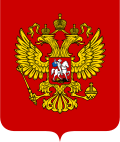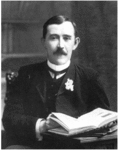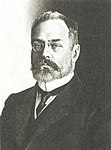January 1907 Russian legislative election
| |||||||||||||||||||||||||||||||||||||||||||||
All 518 seats to the State Duma of the Russian Empire | |||||||||||||||||||||||||||||||||||||||||||||
|---|---|---|---|---|---|---|---|---|---|---|---|---|---|---|---|---|---|---|---|---|---|---|---|---|---|---|---|---|---|---|---|---|---|---|---|---|---|---|---|---|---|---|---|---|---|
| |||||||||||||||||||||||||||||||||||||||||||||
| |||||||||||||||||||||||||||||||||||||||||||||
 |
|---|
|
Parliamentary elections were held in the Russian Empire between January and March 1907. The Trudoviks emerged as the largest bloc in the second State Duma, winning 104 of the 518 seats.[1] Only 26 MPs elected the previous year retained their seats.[2] In Congress Poland, the National-Democratic Party won 34 of the 38 seats.[3]
In 1906, protests against the dissolution of the First Duma had resulted in the publishing of the Vyborg Manifesto, in which members of the Cadets party had called on citizens to engage in civil disobedience until the Duma was reinstated.[4] As a result of this action, these Cadets were made ineligible to vote or stand again for election, which greatly reduced the power of the Cadet party in this and future elections.[4]
Because this election was before the coup of June 1907 (which resulted in the changing of the electoral franchise) and because the Social Democratic Party and Socialist Revolutionaries ended their electoral boycott for this election, the Second Duma was the only one elected in the Russian Empire that included representatives of all the main parties in numbers that even remotely matched those parties’ popularity amongst the public.[5]
The new Duma was opened on 6 March, with Fyodor Alexandrovich Golovin elected as its president.[2] Like the first, the second Duma was dissolved by the Tsar after only a few months in session. Another election was held later that year after the coup of June 1907, which made further parliaments more pro-Tsar by amending the franchise.
Voting system[]
The voting system for the election was complicated, as representatives were not always directly elected.[6] Only nobles elected their representatives directly to the duma, while the rest of voters elected representatives to an electoral 'college', which in turn elected duma members.[6] Because of this, 1 noble's vote was made equivalent to 2 townsman’s votes, 15 peasant votes and 45 urban worker votes.[7]
Government interference[]
In this election, the government and particularly Prime Minister Pyotr Stolypin actively sought to interfere in the election campaign in order to support conservative parties which were friendly to the Tsarist regime.[8] The electoral rights of so-called "undesirable" groups were denied, while conservative groups were covertly financed, with the government devoting three million rubles to this purpose.[8] As such, it sought to enhance the moderates' and conservatives' chances of winning elections to the Second State Duma.[8] However, interference in the elections would ultimately produce mixed results.[8] The electoral alliance between the Octobrists and rightists were helped to prevail easily in the landowners curia, with the government excluding viable private peasant proprietor candidates from this curia.[8] In the other curiae, however, government interference had less of an impact, with the urban electorate and peasant curia largely still voting for opposition parties.[9] This was despite government pressure being most prevalent in the peasant curia.[10]
In many ways, the Tsarist government considered the powerful centrist Kadets to be more dangerous threat than the revolutionary parties, as they were perceived as revolutionaries in all but name.[11] As a result, the Kadets were subject to some of the most vigorous government repression.[12]
Results[]
| Party | Seats | +/– |
|---|---|---|
| Trudoviks | 104 | –1 |
| Constitutional Democratic Party | 98 | –86 |
| Autonomists | 76 | – |
| Russian Social Democratic Labour Party | 65[a] | New |
| Socialist-Revolutionary Party | 37 | New |
| Moderates and Octobrists | 32 | New |
| Right-wing | 22 | New |
| Cossack Group | 17 | New |
| Popular Socialists | 16 | New |
| Party of Democratic Reform | 1 | –13 |
| Independents | 50 | –53 |
| Total | 518 | +19 |
| Source: Great Russian Encyclopedia | ||
Some sources assert that, at the start of the parliament, the Cadet faction numbered 105 deputies while the Trudoviks originally had around 80 deputies.[14] This would have made the Cadets the largest faction in the Second Duma immediately after the election ahead of the Trudoviks. The number of deputies for each party changed over time during the course of the parliament as members aligned themselves with different political groupings.[14] Whilst the Trudoviks started with around 80 deputies, in late February and March 23 more deputies switched their allegiances to the Trudovik faction.[14]
Of the 65 Social Democrat deputies, 47 were Mensheviks and 18 were Bolsheviks.[13]
Majority[]
No one party held a majority of the seats after the election, but, like in the First Duma, the Cadets effectively ran the Duma.[15] The newly elected chairman of the Duma was a Cadet, as was the secretary and most of the chairs of the commissions and subcommissions.[15] The key positions in the Duma were held by the Cadets, Trudoviks and the Polish autonomists (who held 46 seats), and any two of these factions could form a majority in the Second Duma in voting.[16] Essentially, an effective majority was formed by virtue of a loose coalition between the Cadets, Trudoviks and Socialists, with these groups in consensus over the need for radical democratisation, property redistribution, legislation that served the interests of the poor and over their hostility towards the government.[16] The Cadets and Trudoviks also agreed on the need to safeguard the Duma and to use it as an instrument of reform, and until early April the Trudoviks' group leader was set on cooperation with the Cadets.[17] Overall, these factions as a whole formed the leftist-Cadet majority, which by the end of the session comprised 350 deputies.[16] The autonomists also voted with this 'revolutionary majority' on a number of occasions, bringing this majority to 425 deputies, and on individual items of business the moderates and Octobrists joined them.[16]
Despite this, this voting coalition was fragile.[16] The delicate voting coalition ended up breaking down in April after the reading of a conscription bill, when the socialists and some of the Trudoviks voted against a military draft, whereas the Cadets and the autonomists voted in favour.[16] Part of the reason for the breakdown of the wider voting bloc during the Second Duma was because the Cadets often attempted to find a middle ground between the left and right wings of the Duma, and so exposed themselves to hostility from both sides.[18]
Had the government come to an agreement and understanding with the large centrist Kadet party in this or in the First Duma, it is likely that this would have facilitated Russia's transformation into a modernised, constitutionalised nation without the need for any revolutionary violence.[19]
Work in session[]
After meeting, much of the Second Duma's focus centred on attempts to expand the authority of the representative body, which had been deliberatley curtailed before the first elections by the Tsar in the 1906 Russian constitution.[20] The main focus of delegates' attention was on land reform.[20] Compared to the First Duma, less attention was given to challenging the government on governmental drafts and counter-revolutionary repressions, while there were less clashes over improvements of the plight of the lower classes.[20] Discussions on these issues had seen the First Duma dissolved after only 10 weeks.[20] Despite this, the Second Duma remained decisively anti-Tsar.[4]
The Cadets decided that in the Second Duma they should prevent unnecessary clashes with the authorities, as that could lead to early dissolution.[21] They were willing to work with the government and consider implementing their planned legislation.[21] Prime Minister Stolypin also attempted to pass generous laws allowing personal freedoms, civil liberties and local self-government during the session.[22] Stolypin willingly attempted to work with the duma to pass this civil rights legislation, and promised the proposals of the 1905 October Manifesto would be given official legal status.[22] Those on the right were fully supportive of these proposals.[23] The duma also approved most of the government's budget legislation.[24] When there were disagreements during the session they were often successfully mediated; when the government asserted that the duma should not vote on political amnesty matters as this was the prerogative of the Tsar, a majority voted to create an 11-man committee to establish whether it would be right for the duma to do so.[25]
The Second Duma would only last from 20 February–3 June 1907.[26]
Dissolution[]
The Second Duma was dissolved only 102 days after beginning its term, lasting little longer than the first.[20] The government justified the second premature dissolution by claiming that some members were plotting against the Emperor's family, and that some were plotting a coup d'etat.[20]
Notes[]
- ^ 47 Mensheviks, 18 Bolsheviks[13]
References[]
- ^ "State Duma" Отечественная история с древнейших времён до 1917 года Great Russian Encyclopedia, 1994, pp611–613
- ^ Jump up to: a b "The New Duma", The Times, 6 March 1907, p5, Issue 38273
- ^ "Russia", The Times, 2 March 1907, p7, Issue 38270
- ^ Jump up to: a b c "Attempts to strengthen Tsarism, 1905-1914". BBC Bitesize.
- ^ Demin 2008, p. 34.
- ^ Jump up to: a b Culpin 2012, p. 55.
- ^ Cuplin 2012, p. 55.
- ^ Jump up to: a b c d e Manning 1982, p. 293.
- ^ Manning 1982, pp. 293–294.
- ^ Manning 1982, p. 294.
- ^ Galai 2010, pp. 4–5.
- ^ Galai 2010, p. 5.
- ^ Jump up to: a b Demin 2008, p. 35
- ^ Jump up to: a b c Demin 2008, pp. 38–43
- ^ Jump up to: a b Demin 2008, p. 45.
- ^ Jump up to: a b c d e f Demin 2008, p. 50.
- ^ Demin 2008, pp. 38, 50.
- ^ Demin 2008, p. 46.
- ^ Galai 2010, p. 22.
- ^ Jump up to: a b c d e f "History of the State Duma". duma.gov.
- ^ Jump up to: a b Galai 2010, p. 2.
- ^ Jump up to: a b Galai 2010, p. 7.
- ^ Galai 2010, p. 8.
- ^ Galai 2010, p. 15.
- ^ Galai 2010, p. 14.
- ^ Demin 2008, p. 32.
Sources[]
- Culpin, Christopher (2012). The Russian Revolution, 1894‐1924 (Enquiring History Series ed.). Hodder Education. ISBN 978-1444144567.
- Demin, V. A. (2008). "Factions in the Second State Duma". Russian Studies in History. 46 (4): 34–59.
- Galai, Shmuel (2010). "The Kadets in the Second Duma". Revolutionary Russia. 23 (1): 1–28.
- Manning, Roberta Thompson (1982). "Chapter 13: The Second State Duma and the Zemstov Congress of the Right-Wing Parties". The Crisis of the Old Order in Russia: Gentry and Government. Princeton University Press. pp. 293–322.
- 1907 elections in Europe
- 1907 elections in Asia
- 1907 in the Russian Empire
- Legislative elections in Russia
- January 1907 events
- February 1907 events
- March 1907 events





